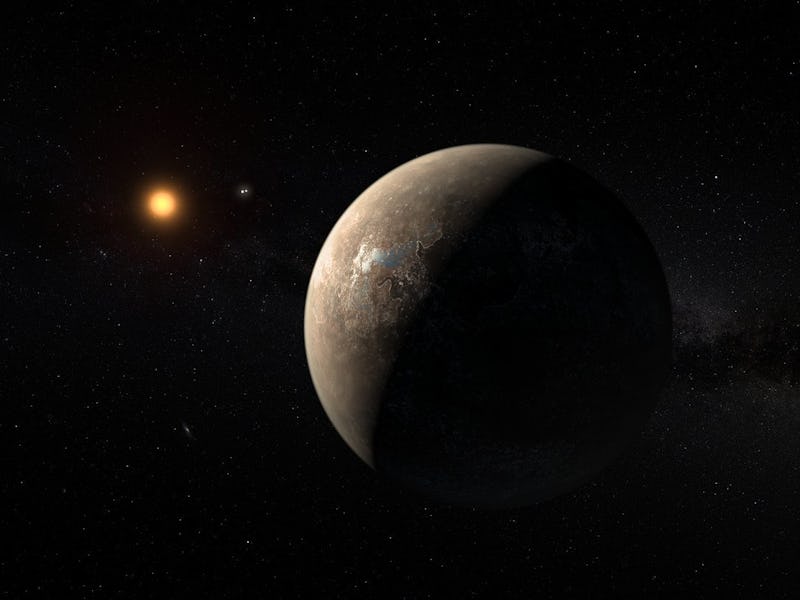There Might Be Another Planet Orbiting Proxima Centauri
We spoke with Gavin Coleman, part of the research team which discovered Proxima b.

The news about a potentially habitable exoplanet orbiting the closest star to Earth outside the solar system is incredibly joyous news. Proxima b, orbiting the red dwarf Proxima Centauri, will be one of the most exciting space discoveries of the decade — and possibly the century.
Inverse spoke with Gavin Coleman, a researcher at Queen Mary University of London and part of the team that discovered Proxima b, about how the discovery happened, what we still don’t know about the exoplanet, and what else might be lingering in the Proxima Centauri star system.
How did you guys find this exoplanet?
Proxima Centauri has been looked at for about 16 years now. So there’s a lot of old data. In about 2012, [lead researcher and fellow Queen Mary University of London researcher] Guillem Anglada-Escudé saw a signal there to indicate the presence of a planetary object. However, the signal wasn’t robust enough to be considered “significant.”
He began the Pale Red Dot campaign to conduct some newer tests. We looked at it again and eventually found a higher signal that was significant.
When did you determine it resided in the habitability zone? How did you guys figure this out?
I think we probably half-knew when we were already examining the orbital periods, in January or February, when we were observing it in greater detail. It worked out exactly to where the known period was, and we knew it was in the habitability zone there.
Besides its orbit residing in the habitable region of the star, do we know anything else about the planet that adds supporting evidence to the idea Proxima b is habitable?
We think it’s rocky, based on the Earth and models of known planets. We think because it’s in the habitable zone it can possess liquid water. A lot of models have shown that if the planet has an atmosphere then it can have liquid water. So if it has an atmosphere, it could have oceans of some kinds, or ice, depending on the location. The gravity should be pretty similar to Earth. We estimate it at about 1.1 g.
There’s nothing on the atmosphere at the moment. If the planet transits (meaning it crosses the host star in front of our perspective from Earth), then we can try to acquire some of that data, since we can look at the light that comes through the atmosphere and determine the composition of atmospheric molecules.
Why does the transit or non-transit of the planet affect what happens next?
If Proxima b transits, we’ll know its radius. With the radius, mass, and density, we’ll be able to figure out the structure and the bulk composition of the planet. We can start to do spectroscopy on the planet to see what the atmosphere is composed of. Whether there’s water molecules, carbon dioxide, whether there are biomarkers present there all of this extra stuff that we can start to look for.
If it doesn’t transit, that’s where we’ll have to wait a while. There’s a new telescope going up from the European Southern Observatory called the European Extremely Large Telescope (EELT) in Chile. And theoretically, on paper, that should be able to directly image the planet.
I think that’s supposed to start up in 2024. So if the planet doesn’t transit, we’ll have to wait maybe about nine years before the next steps.
Do we know anything else about other objects orbiting Proxima Centauri, or any potential moons around the exoplanet?
There are tentative signals of another planet about 100 to 400 days out. It’s not significant yet, but there are some signals which could indicate another planet out there.
For moons, we have to wait til we know if there’s a transit. Because the planet orbits the star so close, there’s not much moon for a moon anyways. One could be there, but it’s probably quite unlikely.
Can you explain how Proxima Centauri being a red dwarf — as opposed to something like our sun — could affect potential life on Proxima b?
So Proxima Centauri is about eight times smaller than our sun. And it’s 1,000 times fainter. So we’re looking at it primarily in the infrared. Any life there is going to be attuned to that type of radiation, as opposed to the green radiation that we’re used to here.
The other thing: Proxima Centauri flares up a lot. Because the exoplanet is so close to the star, the flares can impact the atmosphere. That would make life a bit harder to survive.